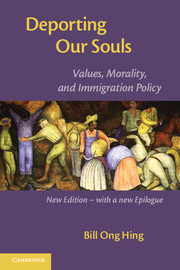Book contents
- Frontmatter
- Contents
- Foreword by Senator Edward M. Kennedy
- Acknowledgments
- DEPORTING OUR SOULS
- Introduction: Hysteria and Shame
- 1 Illegal Immigration: Give Them a Parade
- 2 Deporting Our Souls
- 3 Promoting Family Values and Immigration
- 4 Misusing Immigration Policies in the Name of Homeland Security
- 5 A Welcome Wagon for New Americans
- Epilogue: A Policy of Humanity
- Index
Introduction: Hysteria and Shame
Published online by Cambridge University Press: 18 August 2009
- Frontmatter
- Contents
- Foreword by Senator Edward M. Kennedy
- Acknowledgments
- DEPORTING OUR SOULS
- Introduction: Hysteria and Shame
- 1 Illegal Immigration: Give Them a Parade
- 2 Deporting Our Souls
- 3 Promoting Family Values and Immigration
- 4 Misusing Immigration Policies in the Name of Homeland Security
- 5 A Welcome Wagon for New Americans
- Epilogue: A Policy of Humanity
- Index
Summary
We are a nation of immigrants, but we also are a nation that loves to debate immigration policy. Except for western Europeans, virtually every new immigrant group that arrived experienced derision from nativists. But each newcomer group had its supporters as well. Thus, depending on the era and which side had the most influence, legislative and enforcement policies might be friendly or hostile toward newcomers. For example, these battles led to Asian exclusion laws from 1882 to 1917 and national origin quota systems in the 1920s that disfavored Asians and southern and eastern Europeans, but the debate resulted in more fair immigration categories in 1965 and a limited amnesty program for undocumented aliens in 1986 as well.
Sometimes, the hysteria over immigration policy can lead to cruelties that we later regret, usually implemented when anti-immigrant forces are particularly strong. These include instances of mean-spiritedness that extend beyond a decision simply to admit fewer immigrants per se or to deny admission to prospective immigrants who are criminals or suffering from infectious disease. The Asian exclusion laws and the quota provisions targeting southern and eastern Europeans are prime examples of such disgraceful enactments. Another shameful example is Operation Wetback in 1954, when more than a million undocumented Mexican workers were deported after being recruited and used by American growers for years.
- Type
- Chapter
- Information
- Deporting our SoulsValues, Morality, and Immigration Policy, pp. 1 - 7Publisher: Cambridge University PressPrint publication year: 2006



